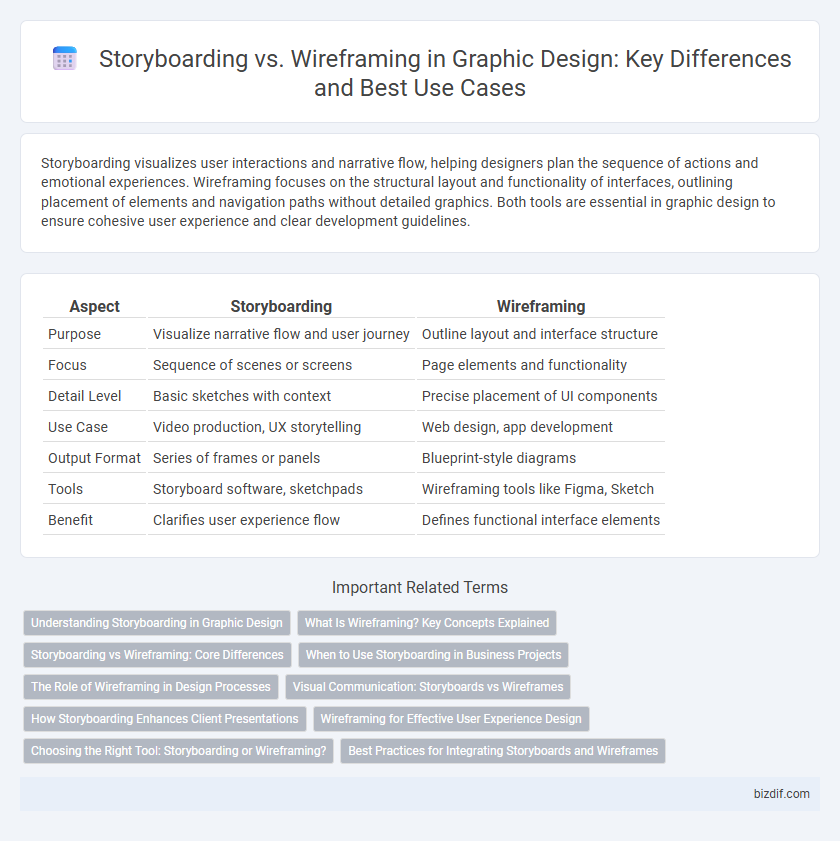Storyboarding visualizes user interactions and narrative flow, helping designers plan the sequence of actions and emotional experiences. Wireframing focuses on the structural layout and functionality of interfaces, outlining placement of elements and navigation paths without detailed graphics. Both tools are essential in graphic design to ensure cohesive user experience and clear development guidelines.
Table of Comparison
| Aspect | Storyboarding | Wireframing |
|---|---|---|
| Purpose | Visualize narrative flow and user journey | Outline layout and interface structure |
| Focus | Sequence of scenes or screens | Page elements and functionality |
| Detail Level | Basic sketches with context | Precise placement of UI components |
| Use Case | Video production, UX storytelling | Web design, app development |
| Output Format | Series of frames or panels | Blueprint-style diagrams |
| Tools | Storyboard software, sketchpads | Wireframing tools like Figma, Sketch |
| Benefit | Clarifies user experience flow | Defines functional interface elements |
Understanding Storyboarding in Graphic Design
Storyboarding in graphic design involves creating a sequence of drawn frames that visually map out the narrative or flow of a project, allowing designers to plan user experience and storytelling effectively. It emphasizes the arrangement of visual elements and transitions to communicate ideas clearly to clients and teams before development begins. Unlike wireframing, which focuses on layout and functionality, storyboarding prioritizes the emotional and chronological aspect of design projects.
What Is Wireframing? Key Concepts Explained
Wireframing is a fundamental graphic design process that outlines the skeletal framework of a digital product, focusing on layout, structure, and functionality without detailed visual elements. Key concepts include placement of interface elements, navigation paths, and content prioritization, which facilitate clear communication between designers, developers, and stakeholders. Unlike storyboarding, which emphasizes user flow and interactions through sequential scenes, wireframing is static, enabling early-stage usability testing and iterative design improvements.
Storyboarding vs Wireframing: Core Differences
Storyboarding visualizes the user journey and interaction flow through sequential illustrations, emphasizing narrative and context in graphic design projects. Wireframing focuses on the structural layout and functionality of a design, presenting a simplified blueprint of interface elements without detailed visual design. The core differences lie in storyboarding's role in storytelling and experience mapping versus wireframing's purpose in planning user interface structure and navigation.
When to Use Storyboarding in Business Projects
Storyboarding is ideal for business projects that require visualizing user interactions and customer journeys, helping teams understand the narrative flow and emotional engagement. It is particularly useful during the early stages of product development when presenting concepts to stakeholders or storyboard-driven marketing campaigns for clear communication. Utilizing storyboarding enhances collaboration by mapping out scenarios, ensuring alignment on project goals before moving to detailed design phases.
The Role of Wireframing in Design Processes
Wireframing serves as a crucial blueprint in graphic design, outlining the skeletal framework of a website or app interface to establish layout and functionality before visual details are added. It enables designers to prioritize content placement, user navigation, and interaction flow without the distraction of colors or images, streamlining collaboration with stakeholders and developers. This early-stage visualization helps identify potential usability issues and refines the user experience, making wireframing an essential step in efficient and effective design processes.
Visual Communication: Storyboards vs Wireframes
Storyboards and wireframes serve distinct roles in visual communication within graphic design; storyboards illustrate a sequence of interactions and narrative flow to visualize user experience and storytelling, while wireframes focus on structural layout and interface elements to define functionality and content hierarchy. Effective storyboarding captures user journeys through dynamic scenarios, enabling stakeholders to understand context and emotion. Wireframes prioritize clarity and usability by presenting simplified, skeletal designs that guide development and ensure consistent user interface organization.
How Storyboarding Enhances Client Presentations
Storyboarding enhances client presentations by visually illustrating the user journey and interaction flow, making abstract concepts tangible and easy to understand. It bridges the gap between initial ideas and final design, allowing clients to visualize sequences and emotions before development begins. This method improves communication, aligns expectations, and speeds up feedback cycles in graphic design projects.
Wireframing for Effective User Experience Design
Wireframing plays a crucial role in effective user experience design by providing a clear and simplified blueprint of a digital product's layout and functionality. It emphasizes structure and content placement without visual distractions, enabling designers to focus on usability and interaction flow. This process helps identify potential user navigation issues early, streamlining the development of intuitive and user-centered interfaces.
Choosing the Right Tool: Storyboarding or Wireframing?
Storyboarding visually maps out user interactions and narrative flow, ideal for illustrating the emotional journey and context of a design project. Wireframing emphasizes the structural layout and functionality, focusing on placement of elements and usability without detailed visuals. Selecting between storyboarding and wireframing depends on project goals: use storyboarding for conceptual storytelling and experience planning, while wireframing is suited for interface structure and interaction design.
Best Practices for Integrating Storyboards and Wireframes
Effective integration of storyboarding and wireframing enhances visual communication and user experience in graphic design projects. Prioritize creating storyboards to outline the user journey and key interaction points, then develop wireframes to define layout structure and functionality with precision. Consistent collaboration between designers and stakeholders ensures alignment on visual narratives and interface elements, resulting in cohesive and user-centric designs.
Storyboarding vs Wireframing Infographic

 bizdif.com
bizdif.com